British Canoe Union (BCU)
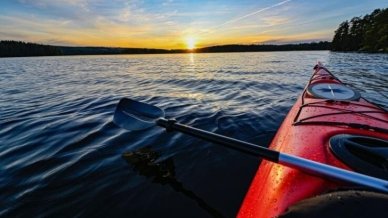
Brief Background
A sharp kayak bow is wafting the river surface, the water is moving around it, and the banks are sweeping past. Time passes, the world opens, and the river road stretches forward. A person is paddling discreetly, peering into the horizon. These make an organic combination of easiness and carefulness, the rhythmicity of movement, and the accuracy of efforts. That is kayaking, rooted in European sports and leisure so long ago that it may seem to have always been there. A human and nature glorified in books and movies are united with ancient traditions.
Kayaking is one of the few sports disciplines, and its origins can be traced to an exact date, year, inventor, and the book/documents that have chronicled the information. There are accurate data on the people and period of its appearance.
Thinking of the kayak's inception, we imagine indigenous inhabitants of the North, who used mobile water transport, made of simple materials like leather and bones of seals, to hunt for seals and other animals. These are the millennial-history boats that were popular among different tribes living on the shores. Who and when was the first to sit in a kayak and shove off is a big 4,000-year mystery. However, we precisely know who was the first to bring kayaking to Europe. It was a Scottish traveller, author, adventurer, and preacher of the middle of the 19th century, John MacGregor.
Jon MacGregor and “Rob Roy”
On July 9, 1865, this man began the history of European kayaking, having paddled down the river Thames with Union Jack to Sheerness on the boat designed and manufactured according to his own calculations at the British firm called Searle's of London. This first European kayak is now kept in Rover and Rowing Musem in Henley.
Jon MacGregor named the kayak after his prominent ancestor, glorified by Walter Scott. Rob Roy was 15 ft long and two feet six inches wide in its widest parts. Besides, there was a four-foot-diameter hole to sit inside and put some stuff. The first Rob Roy had a weight of 90 pounds, a pylon, sails, a double-bladed paddle of Indian sample, and was entirely (apart from sails and equipment) made of oak and cedar.
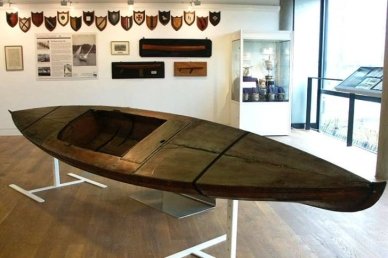
Rob Roy, kept as a museum exhibit
The canoes of North America and Kamchatka inspired John MacGregor to create his first Rob Roy (which was followed by a series of boats in various modifications). Later, he wrote that the very idea of the trip emerged in 1848 in the story told by Archibald Smith about an Indian boat that was a canoe, a bed, and a tent for its owner. Then MacGregor hit on the idea of the solo canoe trip, which would be comfortable and easy to use during a long trip of one person.
John MacGregor wanted a boat to be space-saving and mobile. That would enable him to carry it on the ground or by train without any problems. No boat alike had ever existed before, at least on the British coast. So he decided to create it by himself, considering all possible details. Besides, he was extremely responsible in his approach to challenges and crash tests. And he did it.
Later, in his first book, A Thousand Miles in the Rob Roy Canoe, he provided a story about how he wanted to take all details of boat construction into account before embarking on a journey. John also stressed it was a significant challenge, like a prepared improvisation. He was getting ready for sailing with all his effort. He tried not to miss the smallest detail because they sometimes can make big troubles during sailing, and MacGregor understood it.
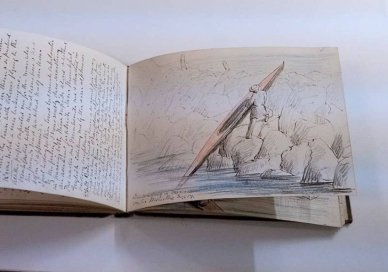
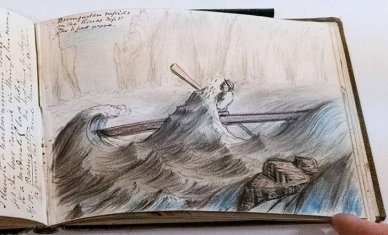
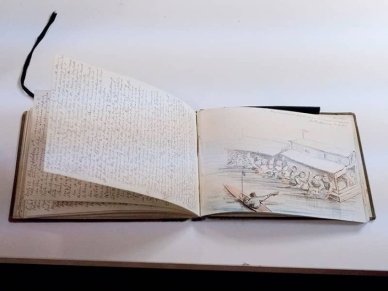
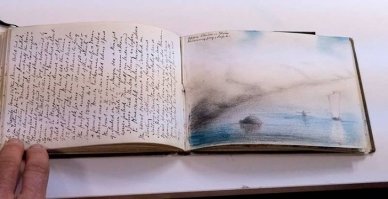
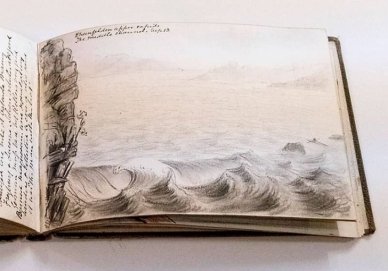
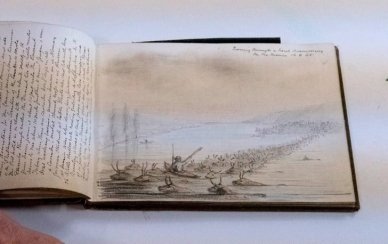
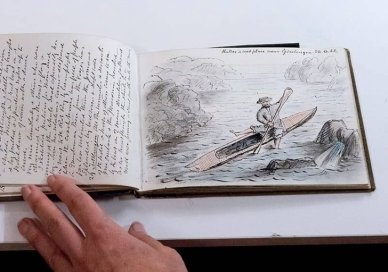
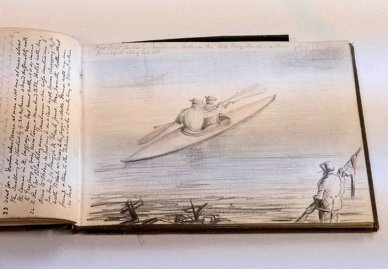
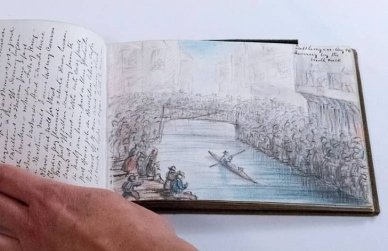
The photos of the manuscript of A Thousand Miles on the Rob Roy Canoe were taken here.
His books on journeys spread all over the world in thousands of copies. Contemporaries read them and derived inspiration. And the fees obtained from the described adventures of MacGregor on Rob Roy were directed to the kayaking clubs that appeared in England one after another. But that happened a bit later.
His first trip on the rivers Meuse, Rhine, Danube, Moselle, and a few lakes in Switzerland lasted almost three months and took around a thousand miles. For the most part of the journey, MacGregor was paddling on his kayak, but he also carried it by train and carriages as it had been decided. Rob Roy became the dream boat (though John MacGregor improved and remade it many times after that).
The first MacGregor trip became the media focus very fast. People used to gather to see the eyes of a desperate traveller firsthand. They would wave from piers, and the newspapers would publish the adventures of Rob Roy every week. In one of the towns along the Rhine in southwest Germany, a group of residents tried to deter MacGregor from passing over the lake. The reason was the local legend about Pontius Pilate. They believed that the latter lived on the bottom and wrecked the boats. Spoiler: he did not.
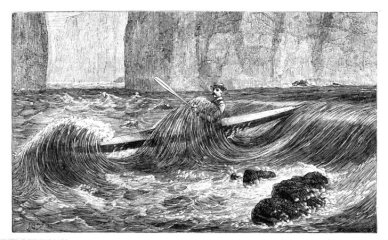
An illustration from the book A Thousand Miles on the Rob Roy Canoe
There were plenty of such adventures. And it is not strange that the books on Rob Roy's trips had immense popularity among their contemporaries. Those were the easily written stories of a man who loved his undertaking with all his heart.
When John MacGregor returned to London to Westminster Bridge on September 7, 1865, he became the hero of the hour, and the whole world was talking about him and his heroics. He inspired others to try and harness the waves and to write a book for sure.
Though MacGregor was the first, as it often happens, his followers in the field of literature were more famous. For example, Inland Voyage by Robert Louis Stevenson (1876) appeared as a description of trips on Rob Roy inspired by MacGregor's stories. And it is now more known to modern readers than the stories of John MacGregor himself.
Since then, the kayaking virus began to spread fast across Old Europe. MacGregor completed boat trips across Norway, Denmark, and Germany. Ten years after Rob Roy's creation (1874), he established the world’s first canoeing and kayaking club. MacGregor was actively developing the club and invested all his money obtained from the sold books. European kayaking could not cease to exist.
British Canoe Union (BCU)
Nowadays, canoeing is about paddling in the open and deckless boat (there are canoes with decks too), which moves with the help of a single-bladed paddle. A kayak has a closed deck and is rowed by a human sitting inside with a double-bladed paddle.
In Great Britain, the term canoeing is often used for paddling a canoe and a kayak, while they use different terms in North America.
In 1887, kayaks/canoes became extremely popular, and the number of their fans increased so sharply that the British Canoe Association was established and existed for 30 years.
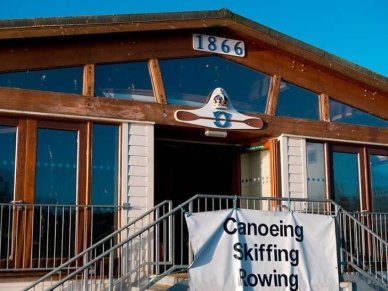
Royal Canoe Club established in 1866
In 1933, the British Canoe Association merged with British Camping Club. Three years later, the representatives of the Camping Club canoe section, Clyde Canoe Club, Manchester Canoe Club, and the Royal Canoe Club established the British Canoe Union (BCU). Nowadays, it is the most known and world-recognized supplier of paddling sports classifications.
British Canoe Union was created to send the canoe paddlers team to the Berlin Olympics in March 1936. Their motto was to help and inspire people to canoeing.
The company was registered on October 30, 1980, and united English, Scottish, and Welsh clubs continuing the traditions of 1936.
Presently, it is a leading canoeing and kayaking organization in Great Britain, though it has another name now. For that period, the community has significantly expanded, and the BCU competencies, opportunities, and sphere of influence have grown as well. Since 1980, this has been the leading canoe organization in Wales, England, the Canoe Association of Northern Ireland, and the Scottish Canoe Association.
In 2000, the British Canoe Union got federalized. In England, Canoe England was established as the BCU branch along with other national associations to support the paddling development in the state.
BCU began operating as a member organization for English canoeists in cooperation with its colleagues in other countries. Initially, the collaboration was unofficial in Scotland (Scottish Canoe Association), Wales (Canoe Wales), and the Canoe Association of Northern Ireland (Canoeing Ireland). Then they made their rapport official based on a range of agreements signed in 1976 and renewed in 2008.
These days, British Canoe Union has united an individual membership of more than 25,000 people, 469 affiliated clubs, and 145 approved centres. According to their own estimates based on the paddling sports reviews, two million people get to the water by canoe annually under the supervision of one of 13,000 qualified BCU coaches or as a part of its subsidiary.
British Canoeing
In 2014, BCU got a new name, British Canoeing, and united former BCU, Canoe England, and GB Canoeing. However, some may get confused these days because the Union comprises four countries and does not represent only great Britain by itself.
Nowadays, British Canoeing is responsible for managing and setting the general framework for all national associations and such spheres as training, competition, and representation of canoeing interests in Great Britain.
According to the official website, British Canoeing aims to “inspire people to pursue a passion for paddling; for health, enjoyment, friendship, challenge, and achievement.”
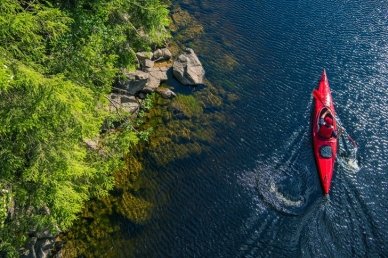
A person in a canoe
British Canoeing is a member organization for canoeists residing in England and also plays a significant role within Great Britain, combining other three national associations (Scottish Canoe Association, Canoe Wales, and Canoeing Ireland). They train and organize international teams participating in competitions controlled by the International Canoe Federation. That concerns all sports: recreational or competitive, paddling open and closed boats, rowed by single- or double-bladed paddles, in internal or coastal waters, or the mid-ocean.
The headquarters of modern BCU is the National Watersports Centre in Nottinghamshire, England, which used to be the Canoe England base. Before that, it had been based in Bingham, Nottinghamshire.
British Canoeing regulates the rules of competitive canoeing applied across Great Britain. It is a unique national sports certification body and, as a result, demands a constant mandatory membership to keep the qualification of sports people valid.
The British canoeing program has been internationally recognized as a golden standard of preparation for paddling. It undergoes constant improvement to satisfy the needs of paddlers, leaders, and coaches.
British Canoeing provides its members with a license to use their canoes, kayaks, and SUPs on the most controlled waterways of Britain and Wales, including the ones under the control of the two largest navigation bodies: Canal & River Trust and Environment Agency. In practice, British Canoeing members do not need to buy a separate license, while non-members are supposed to pay a lump tax sum to go down by the English and Welsh rivers.
River Access for All
English canoeists have tried to solve this problem for more than 50 years. There is even a company called River Access for All that aims to alter the legislation to free the rivers for canoe paddlers.
The goal is to change the legal acts of England and Wales similar to the ones in Scotland. That will help make more rivers available for the public. Currently, access to waters is restricted under English and Welsh legislation, and only 2% of all rivers in England and Wales can be available publicly tax-free.
British kayaking and canoeing have gone a long path from the adventure of John MacGregor and his Rob Roy to the golden paddling standard and the fight of modern kayakers for their right to paddle down the English rivers for free. And only time will show how history will run its course.
You can derive more inspiration and get more information about this fascinating sport via the following links:
Youtube: British Canoeing TV
Handbook: Canoe and Kayak Handbook
Amazon: British Canoe Union Coaching Handbook: Franco Ferrero: 9780954706166: Amazon.com: Books
Contact Information
Address: Great Britain, Adbolton Lane, West Bridgford, Nottinghamshire, NG12 2LU
- Official website
- britishcanoeing.org.uk
- Phone
- +443000119500
- [email protected]

